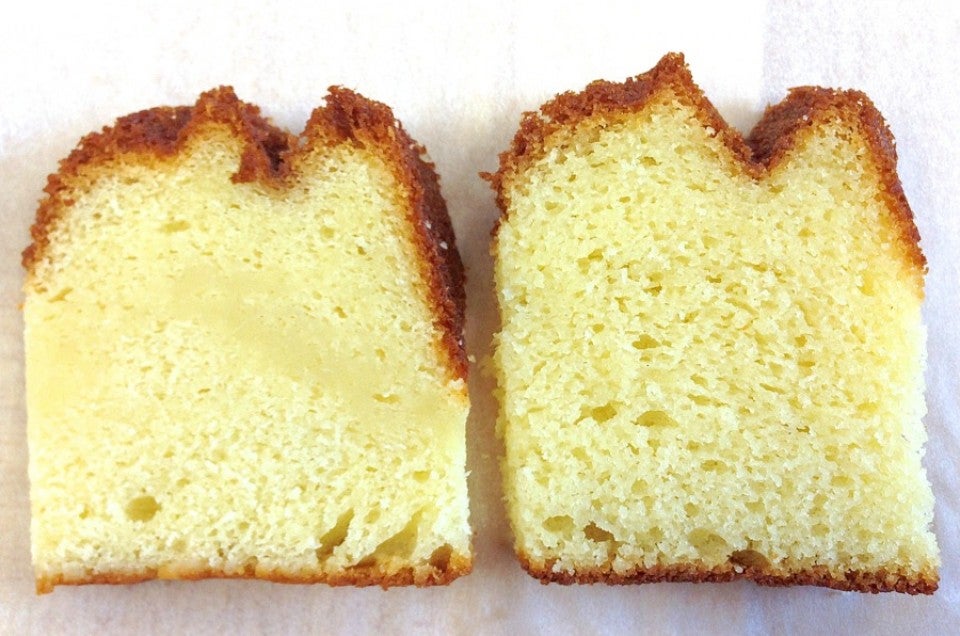


See the two slices of lemon cake above?
The one on the right has a typical texture: an even, fairly close grain.
But the one on the left shows streaks – areas of dense, sodden cake. Taking a bite, you'd think it was under-baked – even though it's actually completely baked.
One of my fellow King Arthur Flour test bakers, Frank Tegethoff, recently called me into the test kitchen for show & tell.
We bakers often do this with one another – "Hey, wanna see something interesting?" someone will say, pulling a deflated loaf of bread, ultra-flat cookie – or perfectly shaped muffin – out of the oven.
We then gather around for a quick lesson in the particular area of baking science demonstrated by said unsuccessful (or super-successful) baked good.
Frank said, "Both of these slices of cake are from the same recipe. Same ingredients; same pan. Same baking time and temperature. Why do you think this one has this pasty middle, and the other one looks fine?"
I considered the question. Preparation method must be the variable. "Ummm... something about how you put together the batter?" (The girl's a genius!)
Frank proceeded to share his secret. The cake with the pasty center was "over-creamed."
"How do you over-cream cake batter?" I asked. "I thought the more air you beat in, the better."
Frank explained that's true, but creaming (beating together sugar, butter, and eggs) has to be done slowly; "no higher than medium speed."
And once any flour is added, the mixing has to be slower still. Developing the flour's gluten too much means the cake will rise beautifully in the oven – then sink (a little, or a lot) as soon as you pull it out.
And the sinking cake is what makes dense, moist, gluey streaks.
Lesson learned: beat butter and sugar and eggs at medium speed. Once you add flour, mix gently.
Thanks, Frank!
Since you can't be right here in the test kitchen with us, we offer you the next best thing: our toll-free baker's hotline, staffed by test kitchen bakers. Next time your cake collapses, your cookies crumble, or your bread behaves badly, call us: 855-371-BAKE (2253). We're here to help.
By the way, since I know you'll ask – that's Lemon Bliss Cake Frank used in his experiment.



March 11, 2015 at 11:06am
March 11, 2015 at 11:44am
In reply to I have a chocolate cake recipe that this happens to. You add t… by Kim Onofrio (not verified)
March 9, 2015 at 2:28pm
March 9, 2015 at 3:10pm
In reply to I have cakes rise beautifully, then fall while cooling a few mi… by Betty Harvey (not verified)
March 6, 2015 at 1:59am
March 6, 2015 at 4:44am
In reply to Hi, I'm British and use Kenwood. On a Kenwood Major prem… by Christiana (not verified)
March 1, 2015 at 9:52am
March 1, 2015 at 10:07am
In reply to I Recently started making cakes with my own twist. But I add to… by Shai (not verified)
February 27, 2015 at 1:07pm
February 27, 2015 at 1:35pm
In reply to What a great tip I bake lots of cakes and some I've had those s… by Peggy Eifler (not verified)
Pagination